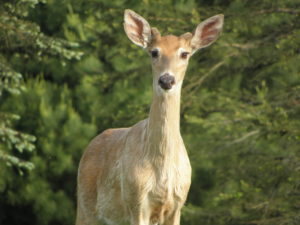By Glen Wunderlich
Michigan’s Department of Natural Resources (DNR) has its hands full with wildlife issues, and accordingly, what follows is a brief outline of some of pro-active measures being proposed for adoption by the Natural Resources Commission (NRC) for the 2017-2019 deer regulation cycle.
CWD: With the onset of chronic wasting disease (CWD) and its recent discovery in yet more areas, the DNR proposes amending the protocols and control measures in the Wildlife Conservation Order by adding Portland and Danby townships in Ionia County and Roxand Township in Eaton County to Deer Management Unit (DMU) 333. This area encompasses that of the latest CWD discoveries and would create a new core CWD area, DMU 359, which includes Mecosta, Austin, Morton, Hinton, Aetna, and Deerfield townships in Mecosta County, and Cato, Winfield, and Reynolds townships in Montcalm County.
Deer checks would be required in DMU 359, as well as all protocol already in place elsewhere in the state.
Disease Control Permits also would be provided to landowners within DMU 359.
A disease management hunt may be authorized, lasting no longer than nine days between January 2 and March 31, if additional harvest is deemed necessary to meet disease management objectives. This measure can be implemented in the event hunters do not kill enough deer during normal hunting seasons.
Antler Point Restrictions: In 2013, the NRC approved a measure from the Northwest Michigan Branch of the Quality Deer Management Association (QDMA) for Antler Point Restrictions (APR) in the Northwest Lower Peninsula requiring that hunters harvest an antlered deer only if they have at least one antler with three or more antler points. A second antlered deer would need to have at least four points on one antler, which is consistent with current regulations elsewhere in the state.
This bold move had to receive a minimum of a 50-percent response level from the area’s hunters. In addition, although the DNR conducted the survey, the expense of the undertaking had to be paid by the QDMA, and when the results were tabulated, an overwhelming minimum of 67 percent of respondents had to be in favor of the proposal.
The measure passed and those I’ve encountered in this area couldn’t be happier with the results. Antler growth, as well as body size and health are appreciably stronger in just a few short years. However, because the regulation has a sunset provision, another survey must maintain the regulation’s acceptance. This re-survey is still being processed for the current APR, but preliminary responses show a 70-percent response rate and an overwhelming 76-percent of hunters in support. Subsequently, the DNR proposes the NRC continue the APR without sunset beginning with the 2017 deer hunting season.
Antlerless Permits: Finally, because of relatively mild winters the past two years, deer numbers are higher in certain areas of the Upper Peninsula and the northern Lower Peninsula. As a result, 5 of the 22 Deer Management Units in the U.P. are proposed to be open for antlerless hunting, as well as the entire northern Lower Peninsula on both public and private lands. Of course, all of the southern Lower Peninsula is to remain open to liberal antlerless hunting, as well.







